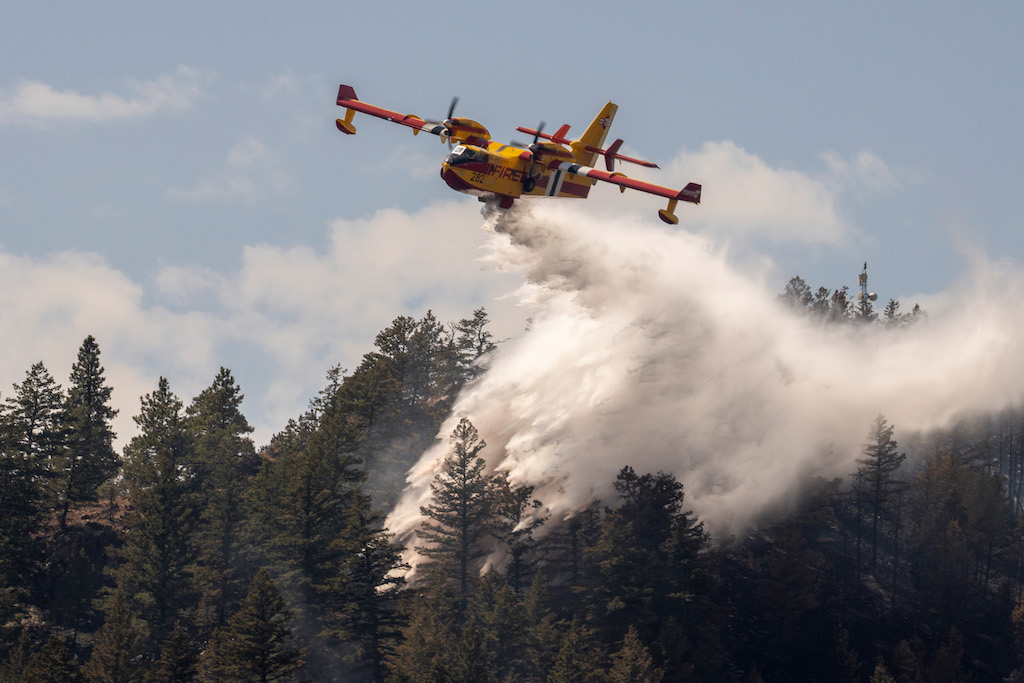
According to NOAA’s National Severe Storms Laboratory, there are roughly five-to-10 times as many cloud flashes than ground flashes.
In recent years, outbreaks of dry lightning have been terribly costly.
Lightning ignited 5,300 wildfires in 2020, according to the National Interagency Fire Center in Boise, Idaho. Approximately 20% of wildfires are caused by lightning. In August 2020, an outbreak of dry lightning in Central and Northern California sent more than 15,000 dry lightning bolts striking dry timber over a few days. More than 600 wildfires were ignited which burned more than two million acres.
The outbreak strained available resources as firefighters fought to control five simultaneous lightning-triggered fires that destroyed thousands of homes and killed at least seven people. When these lightning storms continue their march through the Great Basin and into the Rocky Mountains, the demand for initial attack resources across the nation quickly outpaces their availability.
Lightning can strike as far as 20 mi. away from the thunderstorm. Human-caused fires tend to start near people or roads, which means that fire crews can access the fire relatively easily. On the other hand, lightning-caused fires can pop up anywhere.
Since steeply rising terrain is a trigger for atmospheric instability that can trigger thunderstorms, lightning often strikes in remote mountainous terrain. This places a higher burden on ground-borne initial attack forces as it increases the amount of time to reach the fire incident. Often the only available means to reach these remote fires quickly is by airborne delivery. If the prognostics about lightning frequency come to fruition, it is certain that aerial firefighting resources will come under further strain.
Pilots working under these conditions need recuperative rest to battle the acute and chronic fatigue. However, a stressful day in the cockpit with high cognitive and emotional demands is likely to increase sleep problems.
A study of the entire population of Helicopter Emergency Medical Services pilots in the Netherlands found distressing shifts to be associated with a longer time to fall asleep. High workload shifts were associated with poorer sleep quality, a longer time to fall asleep and shorter total sleep time. Pilots found it harder to recover from a distressing shift than from a busy shift. The possible explanation is that distressing shifts are more emotionally charged than high-workload shifts.
More Wildfires Equal More Smoke

The smoke from wildfires travels great distances and crosses geographical boundaries, thus states without fires can be negatively affected by smoke conditions. Toxic pollutants can be carried by air currents great distances, causing harmful exposure for populations far away from the wildfires and decreasing visibility over an entire region.
Air quality can be degraded at local, regional and continental scales. Drifting wildfire smoke from western conflagrations, carried by high-level winds, reached the East Coast, creating eerie scenes illustrating the far-reaching effects of wildfires.
Smoke can have a significant impact on the efficiency of air traffic operations. Depending on the angle of the sun and the direction of a landing approach, forward visibility could be nil even though the METAR reports good visibility. Visibility through smoke, especially at the typical shallow angles of final approach, often reduces a normal visibility day (7-10 sm) to less than 3 sm. This makes it more difficult for pilots to see the runway.
Lightning Warning Best Practices
When lightning impacts an airport, safety procedures should trigger ramp closures to suspend outdoor work and bring everyone inside for protection. There are no standardized lightning safety rules employed across the aviation industry. Typically, airline and airport operators use the “first lightning strike” observation within a defined distance of the airport.
According to the FAA, best practices include issuing a weather alert when lightning strikes within eight miles and stopping fueling and ramp operations with lightning strikes within five miles. A generally accepted practice is to resume operations after a 15 min. “all clear” after the last lightning event.
Ramp closures cause expensive downtime and delays, yet the current decision-making process for closing and reopening a ramp is burdened with notable uncertainties. If unnecessarily prolonged, these can cause avoidable inefficiencies not only for terminal and ramp operations but also for traffic management of the national airspace.
The National Center for Atmospheric Research is working toward a better characterization of the true lightning hazard that is needed as basis for improving the safety of outdoor personnel and minimizing avoidable operational inefficiencies.
Research is underway to combine multiple sources of relevant information (e.g., radar and lightning data from more than one source) for a robust diagnosis of lightning threats. Moreover, a nowcasting component is being developed that enables recognizing lightning threats prior to impact, allowing for proactive actions. This proactive capability to alert of impending lightning impacts is of particular interest to airports that seek to balance operational efficiency with safety.
Increased Lightning Will Affect Aviation, Part 1: https://aviationweek.com/business-aviation/safety-ops-regulation/increa…



